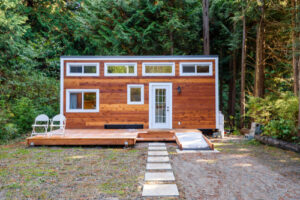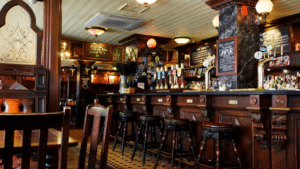Picking the right house to purchase is always a stressful situation. Top that off with finding out the house has knob and tube (k&t) wiring, now that stress has been amplified.
If the house you are looking at is an older house, it could have knob and tube wiring. Just because the home has k&t wiring, it doesn’t mean the house is in imminent danger of burning down. If the wiring has been well maintained it may be just fine.
What is knob and tube wiring?
You will not see any k&t wiring in newer homes. However, if your home was built pre-1950, take a look in the basement as you likely had k&t. Look for wires running through porcelain cylinders or “tubes” inserted in holes in the wooden floor joists. There are also porcelain “knobs,”. These keep the wires secure preventing them from touching the wood along which the wires run. The wires are usually insulated with a rubberized cloth fabric.
Knob-and-tube (K&T) wiring was an early standardized method of electrical wiring in buildings. It saw common use in North America from about 1880 to the 1940s. The system is considered obsolete and can be a safety hazard. However, some of the fear associated with it is undeserved as you’ll read below.
One of the main differences between knob and tube wiring versus modern wiring is the lack of ground wire. Because of this, k&t wiring cannot accommodate any electrical items with three pronged plugs. Additionally, the risk of shocks and fire is much greater. Secondly, the material used to insulate the wire is different. Modern wire uses plastic where k&t uses rubber. The rubber breaks down over time and becomes brittle which is frequently the reason for overheating or mechanical abuse.
Issues with knob and tube wiring
Insulation over the wiring:
With the wiring being coated in a rubber/cloth insulation, it needs lots of space to dissipate the heat that builds up when an electrical current is flowing through. If these wires are surrounded by housing insulation, it is a fire waiting to happen.
Excess use:
When knob and tube wiring was first used there were very few electrical appliances in the average house. Nowadays, with people having more appliances on a circuit, the system can easily become over heated. These k&t systems where never designed to handle the demand for electricity in the modern world.
Alterations:
As it’s such an old system, proper replacement parts are not always available. This could be the reason a lot of makeshift handyman fixes are so dangerous. Knob and tube wiring is typically easily accessible in the basement. This is perhaps the reason why this wiring is often spliced unsafely with modern wiring by home handymen. We always recommend you get a certified electricians.
Damage:
Serious problems can occur if this type of wiring is damaged. This damage could be from either due to wear and tear, handyman fixes, or other types of damage. Porcelain knobs and tubes can crack, and the wires tend to sag and fray over time exposing live wires.
Brittle insulation:
As mentioned above, the rubberized cloth insulation on k&t wiring becomes brittle over time, and can flake off. This then leaves the bare wire exposed.
Possible issues obtaining home insurance
When shopping for home insurance, the insurance company will always want to know what time of wiring your home has.
Some companies will refuse to insure you if your house has k&t wiring. This is because they consider the risk to be too high. However, there are companies that will insure you home but at a higher premium or deductible.
Additionally, they may require an electrical inspection done by professional Guelph electricians before your insurance company will offer coverage. Have other questions regarding obtaining home insurance and other things to look out for? Check out our home insurance checklist.
Myths about knob and tube wiring
The Electrical Safety Authority (ESA) has outlined a few myths of knob and tube wiring. They’ve made a great pdf file that summarizes these myths and provides a lot of information.
Myth: Knob and tube wiring is unsafe.
Fact: Knob and tube wiring is safe, if properly maintained by a Licensed Electrical Contractor.
Myth: The Ontario Electrical Safety Code no longer recognizes knob and tube wiring as an acceptable wiring method, so you must replace it.
Fact: ESA and the Ontario Electrical Safety Code recognize knob and tube wiring methods. However, you must follow the Ontario Electrical Safety Code to ensure electrical safety. Rules 12-200 to 12-224 set out the safety standards for installing this type of wiring. See more details of safe and unsafe practices related to knob and tube wiring.
How much does it cost to replace knob tube wiring?
There’s no concrete answer here, because knob and tube could be different in each home. However, it can be very expensive depending on where the knob and tube exists.
This is because the wiring is often found underneath plaster or lathe and different locations within a room. Finding knob and tube is an exploratory endeavour.
You need to find it and then follow where it connects to throughout the house, tracing it back to the original electrical panel or power source. The best suggestion we can give is to get electricians in Guelph to provide an estimate for you, which is usually done at no charge.
Over time, its possible a previous owner of your home replaced some of the knob and tube. Usually when this happens, it’s because they’ve done renovations in a part of a house. The owner has updated the wiring in that area only. Or, alternatively we’ve seen easy to access places with updated wiring. However, the electrician has left the hard to reach (and expensive) locations alone.
It would typically cost to change knob and tube wiring between $8000 and $15,000 Canadian. However this depends how invasive the wiring is. The other consideration: this will be a messy job that requires plaster repair and painting after removal.
Questions regarding knob and tube wiring? Wondering if your house has it? Don’t hesitate to reach out to Beth and Ryan, Guelph Real estate agents.
They would be happy to help answer any questions you may have and direct you to a trusted electrical professional.



